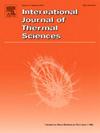Ray tracing core accelerated high performance implementation for infrared radiation signature simulation using reverse Monte Carlo method
IF 5
2区 工程技术
Q1 ENGINEERING, MECHANICAL
International Journal of Thermal Sciences
Pub Date : 2025-03-30
DOI:10.1016/j.ijthermalsci.2025.109904
引用次数: 0
Abstract
Infrared radiation signature is a key characteristic of target and useful for many inverse analyses. Specially, infrared radiation signature simulation plays an increasingly important role in the field of stealth design of air-vehicle and target identification. To improve the simulation efficiency while ensure accuracy, this study presents two novel implementations based on reverse Monte Carlo method. For the first time, hardware ray tracing cores (RT cores) are leveraged to accelerate infrared calculation considering heterogeneous participating media and walls, which is the key innovation compared to the conventional method that only using CUDA cores for acceleration. The first novel method, termed RT method, determines the intersections using bounding volume hierarchy tree (BVH) that implemented on RT cores throughout computational process. Whereas the other, termed CUDA-RT method, determines the intersections between rays and boundaries based on BVH tree that implemented on RT cores, other intersection calculations are done with the help of the adjacency relationships between the grids and are implemented on CUDA cores. Additionally, an improved ray-intersection method is proposed to address complex meshes. A comparison between the numerical and experimental infrared radiation signatures of a rocket-plume case showed the high accuracy of the novel methods. Moreover, a series of numerical examples indicate that both novel methods significantly improved the computational efficiency. Specifically, the CUDA-RT method has the minimum calculation time, approximately 10 % of the reference method with a small additional GPU memory overhead, facilitating improved stealth design and target identification capabilities.
射线追踪核心加速了用反蒙特卡罗方法进行红外辐射特征模拟的高性能实现
红外辐射特征是目标的一个重要特征,在许多逆分析中都很有用。特别是红外辐射特征仿真在飞行器隐身设计和目标识别领域发挥着越来越重要的作用。为了在保证精度的同时提高仿真效率,本文提出了两种基于反向蒙特卡罗方法的新实现。首次利用硬件射线追踪核(RT核)来加速考虑异构参与介质和墙壁的红外计算,这是与仅使用CUDA核加速的传统方法相比的关键创新。第一种新方法被称为RT方法,在整个计算过程中,使用边界体层次树(BVH)在RT核上实现确定交点。而另一种称为CUDA-RT的方法,基于在RT核上实现的BVH树确定射线和边界之间的相交,其他相交计算是在网格之间的邻接关系的帮助下完成的,并在CUDA核上实现。此外,提出了一种改进的射线相交法来处理复杂网格。通过对一个火箭羽流实例红外辐射特征的数值与实验对比,证明了该方法的精度。此外,一系列数值算例表明,这两种新方法都显著提高了计算效率。具体而言,CUDA-RT方法具有最小的计算时间,约为参考方法的10%,并且具有少量额外的GPU内存开销,有助于改进隐身设计和目标识别能力。
本文章由计算机程序翻译,如有差异,请以英文原文为准。
求助全文
约1分钟内获得全文
求助全文
来源期刊

International Journal of Thermal Sciences
工程技术-工程:机械
CiteScore
8.10
自引率
11.10%
发文量
531
审稿时长
55 days
期刊介绍:
The International Journal of Thermal Sciences is a journal devoted to the publication of fundamental studies on the physics of transfer processes in general, with an emphasis on thermal aspects and also applied research on various processes, energy systems and the environment. Articles are published in English and French, and are subject to peer review.
The fundamental subjects considered within the scope of the journal are:
* Heat and relevant mass transfer at all scales (nano, micro and macro) and in all types of material (heterogeneous, composites, biological,...) and fluid flow
* Forced, natural or mixed convection in reactive or non-reactive media
* Single or multi–phase fluid flow with or without phase change
* Near–and far–field radiative heat transfer
* Combined modes of heat transfer in complex systems (for example, plasmas, biological, geological,...)
* Multiscale modelling
The applied research topics include:
* Heat exchangers, heat pipes, cooling processes
* Transport phenomena taking place in industrial processes (chemical, food and agricultural, metallurgical, space and aeronautical, automobile industries)
* Nano–and micro–technology for energy, space, biosystems and devices
* Heat transport analysis in advanced systems
* Impact of energy–related processes on environment, and emerging energy systems
The study of thermophysical properties of materials and fluids, thermal measurement techniques, inverse methods, and the developments of experimental methods are within the scope of the International Journal of Thermal Sciences which also covers the modelling, and numerical methods applied to thermal transfer.
 求助内容:
求助内容: 应助结果提醒方式:
应助结果提醒方式:


